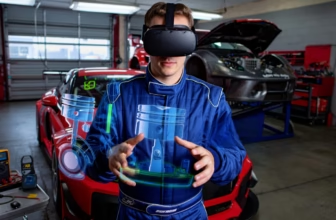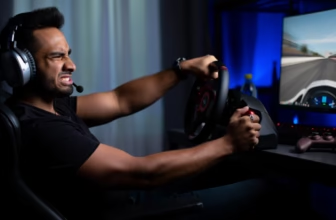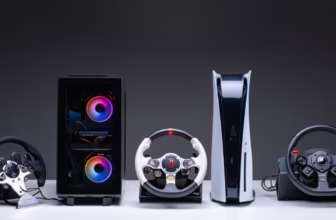
Sim racing has experienced tremendous growth in recent years. Once confined to a passionate and technical community, it’s now opening up to a broader audience thanks to technological advances and more accessible equipment.
Whether to experience the sensations of motorsport or to sharpen gaming reflexes, racing simulators have become a bridge between two worlds: competition and geek culture.
In this article, we’ll explore the essential technologies, emerging trends, and intersection points between sim racing and the geek universe.
The Foundations of an Immersive Sim Racing Setup
Before diving into the details, a quality simulator rests on three pillars: the wheel, pedals, and display.
- Direct Drive Wheels: Today, realism comes through direct drive bases capable of reproducing every vibration and loss of grip. This gives drivers the sensation of actually piloting a vehicle. Unlike traditional belt-driven systems, direct drive technology eliminates mechanical lag and provides superior force feedback precision.
- High-Precision Pedals: Progressive braking with pressure sensors or load cells has become essential for feeling the car and refining racing lines. These advanced pedal systems allow drivers to experience realistic brake pressure and modulation that mirrors real-world racing conditions.
- Display and Immersion: Depending on preferences, some opt for curved triple-screen setups, while others choose VR headsets that literally transport you onto the track. VR technology has evolved significantly, with modern headsets offering improved field of view, higher resolution, and enhanced comfort for extended racing sessions.
From there, each driver can enhance their installation with a cockpit, sequential shifter, handbrake, or custom accessories often inspired by the creativity of geek and maker communities.
Geek Culture‘s Contribution to Sim Racing
Sim racing doesn’t exist in isolation. It shares many commonalities with geek culture: the pursuit of immersion, passion for hardware, and love of customization.
- Visual and Audio Atmosphere: RGB lighting, LED panels synchronized with games, or multi-channel audio systems recall high-end gaming setups. Modern sim racers increasingly integrate sophisticated lighting systems that react to in-game events, creating dynamic ambient environments that enhance immersion.
- DIY and 3D Printing: Many sim racers design their own accessories, custom wheels, or button boxes using plans shared on forums. The maker community has embraced 3D printing technology to create everything from cable management clips to motion platform components, often at a fraction of commercial prices.
- Mods and Online Communities: Like traditional gaming, mods enrich simulators. New cars, realistic tracks, telemetry overlays, and streaming tools allow drivers to adapt the experience to their style. The community-driven development has created an ecosystem where enthusiasts share setups, modifications, and technical innovations.
This fusion between geek creativity and driving precision creates a unique expression platform where enthusiasts can transform their garage into a genuine cockpit worthy of a professional racing team.
Innovations Changing the Game
Recent years have seen several technologies take sim racing to the next level:
- Virtual Reality: VR headset evolution offers expanded field of view and increased comfort, reinforcing the impression of actually being in the driver’s seat. The integration of VR in sim racing has grown, with platforms like HP Reverb G2 and Meta Quest 3 providing high-resolution visuals and natural head tracking.
- Dynamic Platforms: Now accessible to varied budgets, motion systems reproduce vehicle movements and immerse drivers in the physical constraints of racing. Companies like D-BOX and Next Level Racing offer motion platforms that simulate G-forces, weight transfer, and braking dynamics with remarkable precision.
- Software Simulation: iRacing, Assetto Corsa Competizione, and rFactor 2 integrate increasingly precise physics engines with competitive communities and eSports monitoring. These platforms use real-world motorsport data and advanced physics engines to create authentic racing experiences.
- AI-Powered Coaching: Revolutionary AI coaching systems analyze driving data in real-time, providing personalized feedback and performance insights that were previously available only to professional drivers. Platforms now offer data-driven coaching that can help drivers find significant lap time improvements.
These innovations show that sim racing is no longer just a game: it’s a hybrid discipline between motorsport, eSports, and geek culture.
Hardware Selection Guide
Not everyone has an unlimited budget. Here are some guidelines for smart investing:
- Start Simple: A quality mid-range direct drive wheel with force feedback and decent pedals are sufficient to enter sim racing. Entry-level direct drive systems now provide excellent performance at accessible price points.
- Prioritize Upgradability: It’s better to buy evolutionary hardware that can be completed later (cockpit, screens, VR). Modular systems allow for gradual improvements without replacing entire setups.
- Assess Available Space: Triple screens and rigid chassis require space, while compact setups can be easily stored. Consider your available room and whether you need a permanent or temporary installation.
- Compare Reviews and Tests: Enthusiast feedback helps avoid disappointing purchases. Specialized communities and review sites provide valuable insights into hardware performance and reliability.
On this subject, specialized websites such as GeekAventures.fr offer detailed reviews and tests on gaming and high-tech equipment, which are useful for guiding your choice.
The Future of Sim Racing: Convergence of Worlds
The convergence is already evident: sim racing attracts motorsport fans and technology enthusiasts alike. The market is rapidly evolving with mainstream brands entering, rising eSports prominence, and mixed reality solution integration.
The sim racing market is projected to grow rapidly in coming years. This explosive growth is driven by technological advancements, increased eSports interest, and growing accessibility of high-performance equipment.
In this context, the geek community plays a driving role. It pushes manufacturers to innovate, develops custom accessories, and maintains a culture of sharing and passion. The DIY movement has become integral to sim racing culture, with enthusiasts creating everything from custom button boxes to full motion platforms using 3D printing and Arduino-based systems.
Professional eSports has also embraced sim racing, with events drawing global audiences and substantial prize pools. However, challenges remain in spectator engagement and mainstream accessibility compared to traditional gaming eSports.
Conclusion
Sim racing is no longer just simulation: it’s an adventure where sport, technology, and imagination converge. Between cutting-edge equipment, VR innovations, and geek culture, it offers an increasingly immersive experience.
For enthusiasts seeking advice or inspiration, the universe continues to grow and reinvent itself. Whether you’re a beginner virtual pilot or experienced competitor, there’s always new technology to explore, accessories to test, and communities to join.
Sim racing ultimately represents the perfect expression of what geek culture offers best: curiosity, creativity, and unlimited passion. As AI coaching becomes more sophisticated and hardware continues to evolve toward greater realism and accessibility, the line between virtual and real racing continues to blur, creating unprecedented opportunities for both entertainment and professional development.
The integration of haptic feedback systems, advanced motion platforms, and AI-driven performance analysis ensures that sim racing will continue pushing technological boundaries while remaining accessible to enthusiasts at every level. This convergence of motorsport authenticity and technological innovation positions sim racing as not just a hobby, but a legitimate training ground for future racing stars and a thriving entertainment ecosystem in its own right.





